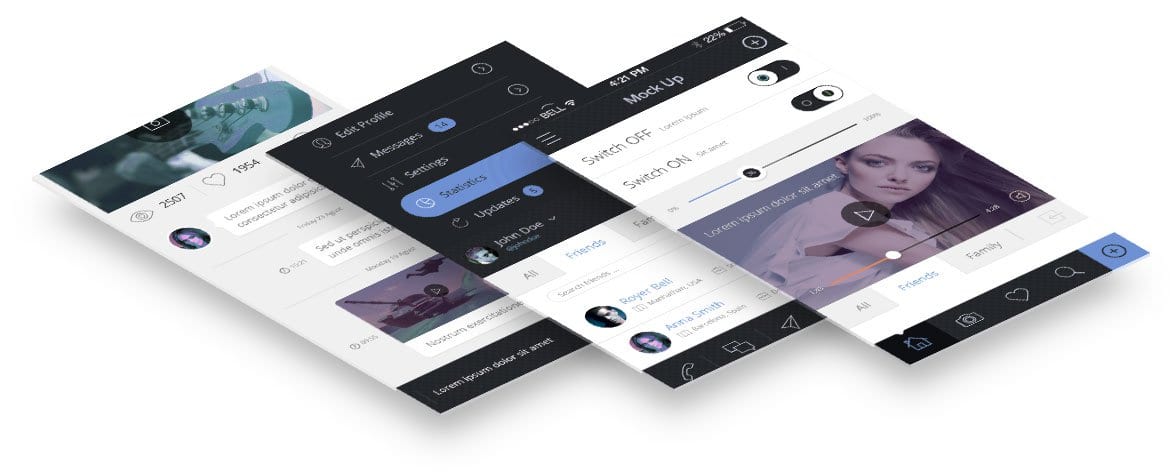In today’s digital age, a strong online presence is crucial for businesses of all sizes. A business website serves as the foundation of this online presence. It provides a platform for showcasing products or services, engaging with customers, and generating leads. However, merely having a website is insufficient; it must be well-designed and user-friendly to effectively reach and engage with audiences. In this article, we will delve into the five essential design elements that every business website needs to achieve maximum impact and success.
User-Centered Design: Focusing on User Experience
Creating a website that prioritizes user experience is crucial for any business. To achieve this, it is essential to have a deep understanding of the target audience and design the website to cater to their needs and goals. Additionally, incorporating user feedback is vital to ensure that the website meets and exceeds user expectations. By taking these steps, businesses can create a website that looks great and functions seamlessly, providing a positive experience for all users.
Understanding Your Target Audience
Businesses must understand their target audience thoroughly to create a successful website. This entails gathering demographic information such as age, gender, and location, as well as delving into their interests and preferences. Armed with this knowledge, businesses can craft a website that truly resonates with their audience and caters to their unique needs. By understanding their target audience, businesses can ensure that their website is not only visually appealing, but also highly functional and user-friendly. This will in turn, lead to higher website engagement and conversions. It will also enable businesses to create more effective digital advertising campaigns and focus their marketing budget and efforts on the right audience.

Designing for User Needs and Goals
Businesses must first gain a comprehensive understanding of their target audience before designing a website that caters to their needs and objectives. This involves crafting a user-friendly layout, ensuring that crucial information is readily available, and presenting clear calls to action. Additionally, businesses should make sure the website is aesthetically pleasing and easy to navigate. They should also ensure that the website is mobile-friendly, as more and more people are accessing the internet from their phones. By doing so, businesses can effectively engage with their audience and achieve their desired outcomes.

Incorporating User Feedback
To create a website that meets its users’ expectations, it is essential to incorporate feedback. This feedback can be obtained through various means such as surveys, user testing, or analyzing user behavior on the website. By doing so, valuable insights can be gained into what aspects of the website function well and what areas require improvement.
Incorporating user feedback is crucial to making a website user-friendly and effective. It allows for a deeper understanding of the needs and preferences of the target audience. This in turn can lead to a more engaging and satisfying user experience. By actively seeking out and utilizing user feedback, website owners can demonstrate their commitment to providing a high-quality service and build a loyal user base.
User feedback is vital to website development. It provides valuable insights into user behavior and preferences, which can be used to improve the overall user experience. By prioritizing user feedback, website owners can create a website that meets but exceeds user expectations.
Consistent Branding: Creating a Cohesive Online Presence
Creating a professional and cohesive online presence is crucial for any business, and branding plays a significant role in achieving this goal. To establish a strong brand identity, it is essential to apply consistent branding across the website and use visual design to reinforce the brand. These design elements are crucial for any business website to effectively communicate its message and values to its target audience. By implementing a well-crafted branding strategy, businesses can establish a strong online presence that resonates with their customers and sets them apart from their competitors.
Establishing a Brand Identity
Establishing a brand identity is crucial to creating a lasting impression for your business. It involves crafting a distinctive visual identity that accurately represents your brand. This includes designing a logo, selecting a color palette, and choosing typography that aligns with your brand’s values and personality. Your brand identity should reflect your business’s unique character and values, and be consistent across all marketing materials and platforms. By creating a strong brand identity, you can establish a clear and recognizable image for your business. This image will resonate with your target audience and help you stand out in a crowded marketplace.

Applying Branding Consistently Across the Website
Consistent branding across a website is crucial for a professional and cohesive look. This involves a uniform color palette, typography, and imagery throughout the site. By doing so, visitors are more likely to perceive the website as a trustworthy and reliable source of information or products. It also helps to establish a strong brand identity and fosters brand recognition among potential customers. Therefore, it is essential to maintain branding consistency to create a positive user experience and build a strong online presence.
Using Visual Design to Reinforce Branding
Visual design plays a crucial role in reinforcing branding and creating a memorable user experience. It involves utilizing visuals that accurately reflect the brand’s personality and values, while also establishing a distinctive visual style for the website. By doing so, businesses can effectively communicate their message to their target audience and leave a lasting impression. A well-executed visual design can enhance the overall user experience and increase brand recognition, ultimately leading to increased success in the marketplace.
Clear Navigation: Making it Easy for Users to Find Information
Effective navigation is crucial to ensure users can effortlessly access information. To achieve this, it is imperative to organize content in a user-friendly manner, incorporate intuitive navigation menus, and integrate search functionality. These design elements are fundamental for any business website seeking to enhance the user experience and increase engagement. By prioritizing clear navigation, businesses can improve website usability, boost customer satisfaction, and ultimately drive conversions.
Organizing Content for Ease of Use
To ensure user-friendly content, it is essential to organize it in a way that groups similar information together and presents it in a logical order. This approach simplifies the process of finding the necessary information for users. This makes the content easier to scan and understand, as well as more memorable. Additionally, proper organization can help to create a positive user experience, which encourages users to stay on the page and return more often.
Providing Intuitive Navigation Menus
Ensuring intuitive navigation menus is crucial to guaranteeing that users can effortlessly navigate through a website. It is imperative that navigation menus are easily accessible, user-friendly, and comprehensible. By implementing these features, users can seamlessly explore the website and find the information they need without any hassle. Therefore, it is essential to prioritize the design and functionality of navigation menus to enhance the user experience.

Implementing Search Functionality
Incorporating search functionality into a website is crucial in enabling users to locate specific information easily. It is important that the search function is user-friendly and delivers pertinent search results. Implementing a search bar can increase user engagement and improve the overall user experience. Additionally, the search results should be tailored to the user’s needs, offering relevant and helpful information.
Mobile Responsiveness: Designing for a Mobile-First World
In today’s fast-paced world, people are constantly on the go and rely heavily on their smartphones and mobile devices to access information on-the-fly. This makes it essential for business websites to be mobile-responsive and optimized for a seamless user experience.
Understanding the Importance of Mobile Design
A mobile-responsive website design ensures that your website adapts to different screen sizes and devices, providing easy navigation, fast page load times, and clear content display. Neglecting mobile design can lead to an unpleasant user experience, high bounce rates, and ultimately, a loss of potential customers.

Implementing Responsive Design Techniques
Implementing responsive design techniques is crucial for creating a mobile-friendly website. This involves designing with a mobile-first mentality, focusing on the key content and functionality that users need and making it accessible on all devices.
Responsive design techniques include fluid grids, flexible images, and media queries that enable the website to adjust to different screen sizes and resolutions. It’s also important to optimize images and reduce page load times for faster mobile performance.
Testing and Monitoring Mobile Performance
Testing and monitoring your website’s mobile performance is crucial for ensuring a seamless user experience. Tools like Google’s Mobile-Friendly Test and PageSpeed Insights can help identify issues and provide recommendations for improving mobile performance. Regularly monitoring mobile performance metrics like bounce rates, page load times, and conversion rates can help identify areas for improvement and ensure a positive user experience for all visitors.
Call-to-Action: Encouraging User Engagement and Conversions
A call-to-action (CTA) is a crucial element that encourages users to take a specific action on your website, such as signing up for a newsletter, making a purchase, or filling out a form. Designing clear and compelling CTAs that stand out on the page can greatly increase user engagement and conversion rates.
Defining Clear and Compelling Calls-to-Action
Strategically placing the Call-to-Action (CTA) on your webpage is crucial to driving conversions. To ensure that your CTA is noticed, use contrasting colors and design elements that draw the user’s attention. The text should be clear and concise, with a strong action-oriented message that encourages users to take a specific action. Avoid using generic and vague language that can lead to confusion or indecision.
For maximum visibility and impact, place the CTA near the top of the page. This will ensure that users see it immediately upon landing on your page. Additionally, make sure that the CTA button stands out from the rest of the page elements. This can be achieved by using a bold color or a larger font size.
When crafting your CTA, keep it concise and to the point. Users should be able to understand the message quickly and act on it without hesitation. By following these guidelines, you can create a powerful CTA that drives conversions and helps you achieve your business goals.
Designing Buttons and Forms for Maximum Effectiveness
The design of buttons and forms can greatly impact their effectiveness in driving user engagement and conversions. Buttons should be large and easily clickable, with clear visual cues that indicate their purpose. Forms should be designed to be visually appealing and easy to fill out, with clear labels and minimal required fields.
The overall design of the CTA should also be consistent with the overall design of the website, creating a cohesive and seamless user experience.

Tracking and Analyzing Conversion Rates
Tracking and analyzing conversion rates is essential for understanding the effectiveness of CTAs and making improvements over time. Using tools like Google Analytics, businesses can track user behavior, conversion rates, and other metrics that provide insights into website performance. Regularly analyzing this data can help identify areas for improvement and ensure maximum effectiveness for CTAs.
Visual Hierarchy: Using Design to Guide User Attention
Visual hierarchy is an important design principle that plays a crucial role in guiding user attention and driving conversions. By using visual cues such as size, color, typography, and spacing, designers can establish a clear hierarchy of information on the screen and help users focus on the most critical elements first.
When done correctly, visual hierarchy helps improve the clarity and usability of interfaces and encourages users to take desired actions with ease. Employing visual hierarchy is an integral part of successful digital experiences that enhances engagement with customers and boosts brand image.
Understanding the Importance of Visual Hierarchy
It is imperative that users can quickly and effortlessly identify the most significant information on the page, such as the company’s branding, key messages, and calls-to-action. This can be achieved through the use of color, contrast, typography, and layout.
By utilizing these design elements, a website can guide the user’s eye to the most relevant information, creating a seamless and enjoyable user experience. A well-executed visual hierarchy can also enhance a website’s overall aesthetic, making it more visually appealing and professional.
Using Color, Contrast, and Typography to Establish Hierarchy
Color, contrast, and typography are essential tools for establishing a clear visual hierarchy on a website. By utilizing a consistent color palette and typography throughout the website, you can create a cohesive and professional appearance that will leave a lasting impression on your audience.
Contrasting colors and font sizes can emphasize critical elements, such as headlines and CTAs, and draw attention to them. However, it is crucial to use contrast sparingly and avoid overusing it, as this can lead to a cluttered and confusing design that ultimately detracts from the user experience.
By implementing these elements thoughtfully and purposefully, you can create a visually appealing and user-friendly website that engages and delights your audience.
Designing for Scannability and Readability
Designing for scannability and readability is important for creating a website that is easy to read and understand. Using short paragraphs, bullet points, and headings can make content more scannable, while choosing fonts and font sizes that are easy to read can improve readability.
It’s also important to consider the background color and contrast between text and background to ensure readability. A website that is easy to read and understand can greatly improve the user experience and lead to increased engagement and conversions.
The Bottom Line for Effective Business Website Design
Having an effective business website is crucial for success. Your website is often the first impression potential customers have of your business, so it’s essential to make it count. By incorporating the essential design elements discussed in this article, such as mobile responsiveness, clear calls-to-action, and visual hierarchy, you can greatly improve website performance and user experience.
Staying up-to-date with the latest design trends and best practices is key to creating a website that stands out from the competition and effectively communicates your brand message. By focusing on user needs, establishing a cohesive brand identity, providing intuitive navigation, designing for mobile responsiveness, and encouraging user engagement, you can create a website that looks great but also achieves your business goals.
Incorporating these design elements into your business website can have a significant impact on its effectiveness and success. So, whether you’re designing your first website or updating an existing one, keep these essentials in mind. This will ensure you’re providing the best possible user experience and driving results for your business.
FAQ: Business Websites
With the rise of mobile devices, having a mobile-responsive website is more important than ever. A mobile-responsive website ensures that your content is accessible and user-friendly on any device, including smartphones and tablets. This not only improves the user experience but also helps to boost search rankings on mobile devices.
While it is possible to design a website without a consistent brand identity, doing so can make it difficult for users to recognize and remember your business. A consistent brand identity helps to establish trust and credibility with your audience, while also reinforcing your value proposition and creating a cohesive online presence.
User-centered design focuses on creating a website that meets the needs and goals of the target audience, resulting in increased engagement and conversions. By understanding the target audience and designing for their needs and preferences, businesses can create a website that effectively communicates their value proposition and drives results.
At ThisGals, we pride ourselves on staying ahead of the curve when it comes to the latest trends and technologies. We understand that keeping up with the ever-evolving landscape of the industry can be overwhelming, which is why we offer our expertise to you.
We invite you to schedule a consultation with us today to discover how we can help you achieve your goals. Our team of professionals is dedicated to providing you with the most innovative solutions that will take your business to the next level.









